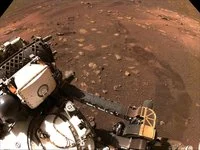
3D Printing Revolutionizes Space Industry: From Rocket Engines to Crushable Structures
The space industry is undergoing a significant transformation thanks to the advancements in 3D printing, also known as additive manufacturing. Once a niche technology relegated to hobbyists, it's now a game-changer for companies like Rocket Lab, Ursa Major, and even NASA, offering faster, cheaper, and more efficient ways to produce complex components.
Rocket Lab, a leading end-to-end space company, has pioneered the use of 3D printing in its Rutherford engine. According to Peter Beck, founder and CEO of Rocket Lab, “Just about all rocket engines these days have at least some significant portion of them 3D printed. It’s really game-changing technology.” The Rutherford engine, a key component of the Electron rocket, is made using additive manufacturing, where powdered metals are meticulously layered to create specialized parts like propellant valves, injectors, pumps, and the combustion chamber.

Jacob Nuechterlein, founder and president of Elementum 3D, emphasizes the process makes it easier to produce complex, intricate elements, noting, “If we’re talking about a slam-dunk application for 3D printing, it’s rocket engines.” He highlights the example of regenerative cooling channels, where cryofuels are pumped through channels embedded in the engine walls to cool it down. A 3D printer can make those cooling channels much tighter, improving engine performance.
The drive for American-made products and increasing tariffs also contribute to the rising importance of 3D printing. Brandon Ribic, technology director at America Makes, notes, “Additive is seen as a type of manufacturing technology that can help enable domestic manufacturing of different types of products. When it comes to tariffs, folks in manufacturing are thinking about that.”
NASA is also actively exploring the potential of 3D printing. Ryan Watkins, a research engineer at NASA's Jet Propulsion Lab (JPL), spoke about developing 3D printed crushable structures for high-speed impact. These structures, including lattices, are excellent for energy absorption and widely used in space applications to reduce shock during deployment, landing, and separation. Watkins noted that the possibilities for such lattice structures have expanded significantly with 3D printing, making it easier to produce a wider range of geometries and optimize their energy-attenuating abilities.
However, challenges remain. Scalability and overall process flow are limitations, according to Watkins: “At JPL, we’ve recently shifted our mindset to recognize that adoption requires experience, and experience only comes from actually using the technology—even for more routine applications.”
Despite these challenges, the future of 3D printing in the space industry looks bright. Companies like Ursa Major are already manufacturing rocket engines that are at least 80% 3D-printed, producing combustion chambers in less than a week compared to the months it used to take with traditional methods. Doucette of Ursa Major emphasizes the growing demand for rocket engines and the need to modernize the industrial base: “When we look at the rocket engine problem, the issue is we’re seeing the demand. And the industrial base is built on technology from 50 years ago.”
3D printing is not just about speed and cost savings but about enabling innovation that was previously impossible. As Shawn Phillips, chief of the Rocket Propulsion Division within the U.S. Air Force Research Laboratory, puts it: “Additive manufacturing can build things that you could never do before with traditional manufacturing techniques.”
The innovative use of 3-D printing has opened doors to more possibilities in not only space but also commercial and military applications. Ursa Major's work with the U.S. Air Force Research Laboratory to test hypersonic technology, with up to 80% of their rockets manufactured using 3-D printers, makes it a strong possibility for domestic manufacturing.
Where will 3D printing take the space industry next? Will it lead to even more innovative designs and capabilities? Share your thoughts and predictions in the comments below.